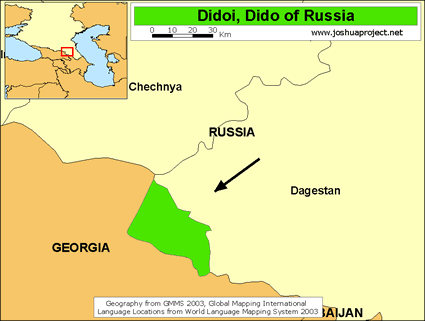
Sudden Death of Ethnic Minority Champion in Dagestan Raises Suspicions
Publication: Eurasia Daily Monitor Volume: 8 Issue: 26
By:

On February 5, it came to light that Magomed Gamzatov, the outspoken leader of the Didoi (aka Tsez) minority in Dagestan, died under suspicious circumstances. The Didoi people and Gamzatov made headlines in Russia in December 2010, when they requested protection from the Georgian government to support and promote their ethnic identity. The Didoi live in southwestern Dagestan, in the mountainous territory bordering Georgia. While the group is habitually assigned the Avar ethnic identity, the largest ethnicity in Dagestan, the Didoi oppose it and maintain their own distinctness separate from the Avars (www.kavkaz-uzel.ru, February 5).
On December 15, 2010 Georgia’s parliamentary committee on Diaspora and Caucasus issues revealed it had been approached by a Didoi representative requesting that the Didoi people enter into “the jurisdiction of Georgia” (www.civil.ge, December 15, 2010). In televised comments, Gamzatov told the Georgian parliament and media about the Russian government’s attempts to suppress their ethnic identity. To support his claim, Gamzatov provided the signatures of 14,000 Didoi people who wanted to be transferred along with their land from Russia to Georgia. According to the Georgian parliament’s committee for Diaspora and Caucasus issues, no territorial issues were discussed; instead, the committee focused on issues related to culture, where Georgian linguists could be of assistance. According to historians, the Didoi people tried to join Georgia at the time of the first Georgian republic, which existed briefly after the Russian empire collapsed in 1917 (https://www.youtube.com/watch?v=1b2qmJNmr68).
It later turned out that the 14,000 Didoi signatories did not request their transfer to Georgia directly, but they did authorize their representative, Magomed Gamzatov, to negotiate with relevant parties to resolve their “social and political” issues. In August 2010, Gamzatov visited Moscow and tried to influence the Russian authorities to no avail, so he then turned to Georgia. At a major gathering on January 4, the Didoi supported Gamzatov and demanded that they be given the status of an ethnicity separate from the Avars. Ethnic activists expected to receive government support and representation in the government as a result of official recognition of their independent ethnicity. According to various estimates, the Didoi number between 15,000 to 30,000 in Dagestan (www.kavkaz-uzel.ru, January 6).
The news about the Didoi request to leave Russia came as another embarrassment for the Russian government, casting it as a power that oppresses small peoples of the North Caucasus. Georgia, gradually is becoming a regional rival of Russia in North Caucasus affairs, moved to exploit this, apparently causing an even higher degree of resentment among Russian officials.
Several days before his death, Gamzatov told the Kavkazsky Uzel (Caucasian Knot) website that the local authorities had banned him from visiting his ethnic Didoi kin in the mountains. Later Gamzatov, who had no known health issues, was found dead at his own building site with vomit stains on his shirt. Gamzatov’s relatives immediately accused the security services of poisoning him (www.kavkaz-uzel.ru, February 5).
Dagestan has been known for political killings and an overall high rate of violence for many years. In 2010, according to Kavkazsky Uzel’s count, 685 people, including civilians, government officials, insurgents and policemen, were killed or injured in attacks. The republic experienced five suicide attacks, 112 bomb explosions, at least 128 armed clashes between insurgents and security forces. The attacks in 2010 claimed lives of 78 civilians, including a nine year old child; 124 law enforcement servicemen; and 176 suspected insurgents. Aside from that, law enforcement bodies are suspected of having continued the practice of kidnapping suspected insurgents. Eighteen people disappeared in Dagestan in 2010. Five of them were later found dead, while four returned to their homes and the rest remain missing (www.kavkaz-uzel.ru, January 13).
The Dagestani opposition newspaper Chernovik came up with a simple but plausible explanation for the high levels of violence in the republic. According to the paper, rampant poverty is responsible for increasing levels of volatility in Dagestan. The combination of a low average income and high housing prices in the republic made it all but impossible for many young Dagestanis to aspire to own a home of their own. Adding up the average income and subtracting the minimum living wage from it, the paper figured out that it would take 13 years of savings to enable an average Dagestani to buy a standard home of 18 square meters. That is longer than any of Dagestan’s neighbors in the North Caucasus or even Moscow, with its high housing prices. The same average ratio for Russia as a whole is seven years. Kabardino-Balkaria came closest to Dagestan in the North Caucasus, with its ratio equal to 10 years of savings (www.chernovik.net, February 4).
These calculations are not absolutely accurate. For example, they do not take into account the shadow economy in Dagestan, which is one of the biggest in the North Caucasus and Russia. However, these figures at the same time do have some validity. In addition, the study reflects a growing perception in society of the strong correlation between poverty and the propensity for violence.




